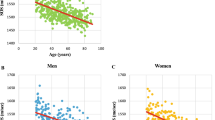Abstract:
Bone loss due to corticosteroid treatment differs from that of postmenopausal osteoporosis with regard to bone structure. Corticosteroids affect both horizontal and vertical trabeculae while horizontal trabeculae are damaged in postmenopausal osteoporosis. Dual-energy X-ray absorptiometry (DXA) is the gold standard to evaluate bone loss. The place of quantitative ultrasound (QUS), a technique that could theoretically provide information on bone structure, is not well established in corticosteroid-induced bone impairment. The aim of the study was to determine the usefulness of QUS in the assessment of corticosteroid-induced bone impairment. We hypothesized that the relationship between QUS and DXA could be influenced by changes in bone structure and thus differ with regard to corticosteroid treatment. Seventy-seven women with inflammatory diseases chronically treated with corticosteroids (dose: 7.5–15 mg/day), 29 without corticosteroids and 100 controls were investigated. Bone mineral density at the lumbar spine (BMDL) was measured by DXA and QUS parameters were measured at the calcaneus. Both the QUS parameters (SOS, BUA, Stiffness) and BMDL were significantly lower (by 1.3% for SOS, 5.8% for BUA, 12.7% for Stiffness and 11% for BMDL) in patients treated with corticosteroids compared with patients not taking corticosteroids and with controls (p<0.001, ANCOVA, with age and height as covariates). Multiple linear regressions of Stiffness, SOS and BUA as dependent variables on age, BMDL, corticosteroid treatment and a computed new variable designed to test the interaction between BMDL and the treatment group showed that Stiffness, SOS and BUA were dependent on age and BMDL (p<0.001); BUA and Stiffness were dependent on treatment group. Taking into account the age of the patients, a significant difference was observed in the relation between BUA and BMDL according to treatment with corticosteroids. A similar difference was found in the subgroup of patients without fractures. SOS and BUA were strongly correlated but their relation did not differ according to treatment. Thus, QUS is useful in the assessment of corticosteroid-associated bone loss. Furthermore, the observation of a significant difference in the relationship between BUA and BMDL with regard to corticosteroid treatment might support the hypothesis that QUS, especially BUA, could give additional information about bone structure.
Similar content being viewed by others
Author information
Authors and Affiliations
Additional information
Received: 24 August 1998 / Accepted: 4 March 1999
Rights and permissions
About this article
Cite this article
Daens, S., Peretz, A., de Maertelaer, V. et al. Efficiency of Quantitative Ultrasound Measurements as Compared with Dual-Energy X-ray Absorptiometry in the Assessment of Corticosteroid-Induced Bone Impairment . Osteoporos Int 10, 278–283 (1999). https://doi.org/10.1007/s001980050227
Issue Date:
DOI: https://doi.org/10.1007/s001980050227




